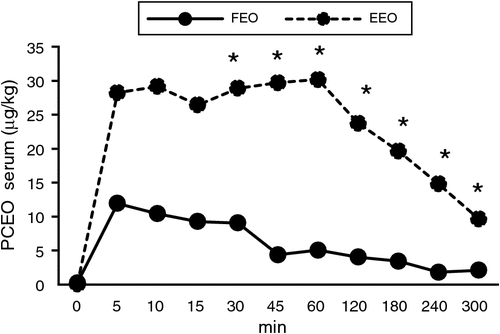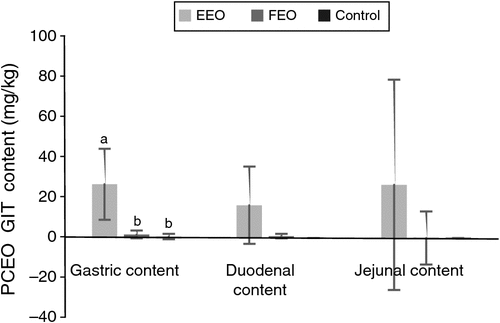In vivo digestion of encapsulated essential oils in weaned pigs
R. Palou A , B. Bhandari A , C. Castro A and E. Roura A BA The University of Queensland, St Lucia, QLD 4072.
B Corresponding author. Email: e.roura@uq.edu.au
Animal Production Science 57(12) 2434-2434 https://doi.org/10.1071/ANv57n12Ab118
Published: 20 November 2017
The antibacterial properties of essential oils (EO) are well known (Hammer et al. 1999). However, most EO are readily absorbed in the gastrointestinal tract (GIT), which potentially limits their in vivo efficacy. Previous studies have demonstrated that effective encapsulation of EO using Ca-alginate does not compromise antibacterial activity (Wang et al. 2009). This study tested the hypothesis that the encapsulation of a mix of three EO with proven antimicrobial activity against enterotoxigenic E. coli could help release the active principle onto the small intestine of recently weaned pigs.
A 200 g mixture including thyme, nerolina and peppermint gum EO were added to a solution of 20 g/L of alginate and 0.5 g of Tween 80 (Croda International, Snaith, DN14 9AA, UK) and blended for 1 min using an Ultraturrax homogeniser (IKA Works, Staufen im Breisgau, Germany). A low flow peristaltic pump with a 21 G needle dropped the emulsion into a 20 g/L CaCl solution. The droplets were left to harden for 30 min. Microcapsules were washed, drained, and stored in a sealed container at 4°C. A catheter was surgically implanted in the external jugular vein of 12 5-week-old male pigs. Treatments consisted of a single oral dose of free EO (FEO) mixed with the morning meal (0.45 mg/kg BW of the principal compounds of each EO (PCEO)), encapsulated EO (EEO, 76 mg/kg BW of microencapsulation) and control (C, feed without EO). Blood samples were collected at 5, 10, 15, 30, 45, 60, 120, 180, 240 and 300 min. Animals were euthanised ~10 h after receiving the treatment and gastrointestinal content samples were collected. Samples were analysed by gas-chromatography/mass spectrometry. Data were analysed by ANOVA using Minitab16 (Minitab Inc., State College, PA, USA).
Compared to the FEO group the serum data indicated that pigs consuming EEO had a significantly (P < 0.05) higher concentration of PCEO at 30 min post-ingestion and thereafter (Fig. 1). A peak for FEO was seen as early as 5 min after intake followed by a slow but constant decrease in the PCEO concentration up to the 5 h timeline. The EEO group exhibited a fast increase followed by a plateau reaching a high level in serum after 5 min and a peak 60 min after intake. In addition, the gastrointestinal data showed a significant (P < 0.05) higher concentration of PCEO from the EEO compared with FEO in gastric contents. The average concentrations for the encapsulated treatment in duodenal and jejunal contents (Fig. 2) were also numerically higher but no statistical significance could be found due to a high variance. The results indicated that the encapsulation with Ca-alginate liberates only part of the EO (probably the exterior bonded EO) in the stomach while releasing the rest of it in the small intestine.

|

|
In conclusion, the results suggested that the encapsulation of EO with Ca-alginate improved the efficiency of absorption of the EO both short and long-term together with a protective effect of the EO from GIT conditions, particularly in the stomach.
References
Hammer KA, Carson CF, Riley TV (1999) Journal of Applied Microbiology 86, 985–990.| Crossref | GoogleScholarGoogle Scholar |
Wang Q, Gong J, Huang X, Yu H, Xue F (2009) Journal of Applied Microbiology 107, 1781–1788.
| Crossref | GoogleScholarGoogle Scholar |
Supported by the Pork CRC Limited Australia.


